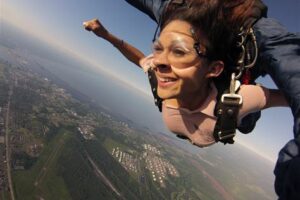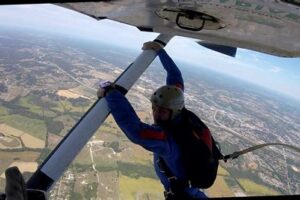Table of Contents
Discover the shocking truth about deaths by skydiving per year. This informative article delves into the statistics and risks associated with this exhilarating extreme sport. Gain insights into the safety measures in place, expert advice, and precautionary guidelines to ensure a thrilling yet secure skydiving experience.
Deaths by skydiving per year is a topic that often sends shivers down the spines of thrill-seekers and cautious individuals alike. With its inherent risks and adrenaline-fueled nature, skydiving has become a popular extreme sport that attracts daredevils from all walks of life. However, beneath the allure lies a sobering reality: every year, there are unfortunate incidents where the joyous descent turns into a tragic event. Nevertheless, it is crucial to approach this subject with an objective lens, evaluating the statistics and factors that contribute to these fatalities. By doing so, we can gain a better understanding of the risks involved and, perhaps, appreciate the bravery and vulnerability of those who choose to take the leap into the unknown.
The Thrill and Risks of Skydiving
Skydiving is an exhilarating adventure sport that involves jumping from an aircraft at a certain altitude and freefalling through the sky before deploying a parachute to slow down the descent and land safely on the ground. It is a popular activity for adrenaline junkies and those seeking a unique and thrilling experience. However, like any extreme sport, skydiving carries inherent risks that participants must be aware of. In this article, we will explore the topic of deaths by skydiving per year and shed light on the safety measures taken within the industry to minimize these risks.
Understanding the Statistics
When discussing deaths by skydiving per year, it is crucial to analyze the statistics objectively. While fatalities can occur during skydiving accidents, it is important to note that they are relatively rare. According to the United States Parachute Association (USPA), there were 15 fatal skydiving accidents in the U.S. out of approximately 2.5 million jumps in 2019. This represents a fatality rate of 0.006%, which is comparatively low when considering the number of jumps performed each year.
Factors Contributing to Fatalities
Understanding the factors that contribute to fatalities in skydiving is essential for addressing safety concerns. The most common causes of skydiving-related deaths include human error, equipment failure, and adverse weather conditions. Human error can range from mistakes made during the jump itself, such as improper body positioning or failure to deploy the parachute correctly, to poor judgment in assessing wind conditions or landing areas. Equipment failure can occur due to manufacturing defects, improper maintenance, or misuse by the skydiver. Unfavorable weather conditions, such as high winds or storms, can also increase the risk of accidents.
Safety Measures in Skydiving
Skydiving organizations and regulatory bodies have implemented various safety measures to mitigate the risks associated with the sport. These measures include:
Extensive Training and Certification
Before individuals can participate in solo skydiving, they are required to undergo thorough training and obtain the necessary certification. This training covers essential skills, emergency procedures, equipment operation, and safety protocols. The USPA, for example, offers a comprehensive program that includes both classroom instruction and practical training jumps to ensure skydivers are well-prepared.
Regular Equipment Inspections
Ensuring the reliability and functionality of skydiving equipment is crucial. Rigorous inspections and maintenance protocols are in place to identify any potential issues before they can compromise safety. Skydivers are encouraged to follow manufacturer guidelines for maintaining their gear and have it inspected regularly by certified professionals.
Weather Monitoring and Restrictions
Weather conditions play a significant role in skydiving safety. Drop zones have strict protocols in place for monitoring weather patterns and making informed decisions regarding whether it is safe to jump. If adverse conditions are present, such as high winds or storms, skydiving operations may be suspended until conditions improve.
Continuous Training and Education
Skydivers are encouraged to pursue ongoing training and education to enhance their skills and knowledge. Advanced courses provide additional instruction on safety procedures, emergency scenarios, and risk management. Staying up to date with the latest techniques and best practices is essential for minimizing the chances of accidents.
The Importance of a Strong Community
The skydiving community plays a vital role in promoting safety and supporting its members. Experienced skydivers often mentor beginners, providing guidance and advice on safe practices. Drop zones foster a sense of community, where individuals can learn from one another, share experiences, and collectively work towards enhancing safety standards.
Investing in Research and Development
The skydiving industry continuously invests in research and development to improve safety equipment and techniques. Advances in parachute design, harness systems, and emergency devices have significantly contributed to reducing the risk of fatalities. Ongoing innovation and collaboration between manufacturers, regulatory bodies, and skydiving professionals are instrumental in ensuring that safety standards continue to evolve.
Learning from Tragedies
When fatalities do occur, the skydiving community comes together to investigate the incident thoroughly. These investigations aim to identify the causes and any lessons that can be learned to prevent similar accidents in the future. Sharing these findings allows the industry to implement targeted measures and improve safety practices.
Conclusion: Embracing Adventure Responsibly
Skydiving undoubtedly carries risks, but with proper training, adherence to safety protocols, and responsible decision-making, these risks can be minimized. The statistics regarding deaths by skydiving per year emphasize the importance of comprehensive training, ongoing education, and a strong sense of community within the sport. By continuously striving for improvement and prioritizing safety, the skydiving industry ensures that enthusiasts can enjoy the thrill of this incredible adventure sport with confidence.
Introduction
Skydiving is an exhilarating and popular recreational activity that allows individuals to experience the thrill of freefalling through the sky. However, as with any extreme sport, there are risks involved. In this article, we will explore the statistics and trends surrounding deaths by skydiving per year.
Overall Fatality Rates
Despite being considered a high-risk sport, skydiving has seen a significant decrease in fatalities over the years. According to the United States Parachute Association (USPA), the overall fatality rate for skydiving in recent years has been approximately 1 in every 100,000 jumps. This highlights the strong emphasis on safety measures and training within the industry.
Experienced Skydivers vs. Novices
The fatality statistics differentiate between experienced skydivers and novices. While beginners may face a higher risk due to relative inexperience, the majority of fatalities occur among experienced skydivers attempting advanced maneuvers. It is essential for all skydivers, regardless of their skill level, to continuously engage in ongoing training and adhere to safety protocols to minimize the risk of accidents.
Incidence of Fatality by Jump Type
Different types of skydiving jumps, such as tandem jumps (where a novice skydiver is attached to an experienced instructor) or solo jumps, have varying mortality rates. USPA statistics indicate that tandem jumps are considerably safer, with a fatality rate of roughly 1 in every 500,000 jumps. Whereas, for solo jumps, the fatality rate is approximately 1 in every 111,000 jumps, emphasizing the importance of proper training and supervision.
Contributing Factors to Fatalities
An analysis of deaths by skydiving per year reveals several contributing factors to accidents. Equipment malfunction, incorrect body position during freefall, pilot error, and failure to deploy the parachute adequately are some common reasons that can lead to fatal incidents. Continuous improvements in equipment design, rigorous training, and strict adherence to safety protocols aim to mitigate these risks.
Age and Gender Patterns
The data shows that the average age of skydiving fatalities is generally between 30 and 49 years old, with a slight male predominance. However, it is important to note that skydiving fatalities can occur across all ages and genders, highlighting the significance of proper safety measures for all participants, regardless of demographics.
Regional Disparities
Statistical variations in skydiving fatalities can be observed across different regions. Factors such as weather conditions, varying regulations, and geographic landscapes play a role in these disparities. For example, some regions with more challenging drop zones or unpredictable weather patterns may exhibit higher fatality rates. Consequently, strict adherence to safety guidelines becomes increasingly crucial in such areas.
Continuous Safety Improvements
The skydiving community is committed to enhancing safety standards continuously. Through rigorous training programs, technological advancements in equipment, detailed incident analysis, and implementation of best practices, efforts are consistently being made to minimize fatalities. These initiatives ensure that skydivers can continue to enjoy this thrilling sport while mitigating potential risks.
Note: The statistics and information provided in this article are based on available data at the time of writing and are subject to change. It is always recommended to consult the latest reports from reputable organizations and professionals within the skydiving industry for the most up-to-date information.
In the world of extreme sports, skydiving stands out as one of the most exhilarating and awe-inspiring activities. However, like any adventurous pursuit, it is not without its risks. Each year, a number of fatalities occur as a result of skydiving accidents. While these incidents are tragic, it is important to consider the statistics and maintain a professional perspective on the matter.
1. Statistical Perspective:
- It is crucial to approach the topic of deaths by skydiving per year with a statistical mindset. Looking at the numbers objectively helps put the situation into perspective.
- According to the United States Parachute Association (USPA), the average fatality rate in the sport of skydiving is approximately 0.006% per jump.
- In 2019, there were 15 fatal skydiving accidents in the United States out of an estimated 3.3 million jumps, resulting in a fatality rate of 0.00045%.
- While any loss of life is tragic, these statistics indicate that skydiving remains a relatively safe activity when considering the vast number of jumps that occur annually.
2. Safety Measures:
- Skydiving organizations and regulatory bodies prioritize safety above all else. They continuously work towards minimizing the risks associated with the sport.
- Equipment standards and maintenance protocols are strictly enforced to ensure the reliability of parachutes, harnesses, and other gear.
- Extensive training programs are in place for both novice and experienced skydivers, emphasizing safety procedures, emergency protocols, and proper techniques.
- Safety briefings, pre-jump checks, and adherence to strict regulations contribute to reducing the likelihood of accidents.
3. Human Error and Risk Management:
- Although skydiving safety measures are comprehensive, human error can still contribute to accidents.
- Many incidents occur due to violations of safety protocols or poor decision-making by individuals involved in the sport.
- Effective risk management involves continuous evaluation of weather conditions, equipment, personal fitness, and skill level to mitigate potential hazards.
- Emphasizing the importance of responsible behavior and adherence to safety guidelines is crucial in minimizing the occurrence of skydiving accidents.
In conclusion, while deaths by skydiving per year are a somber reality, it is important to maintain a professional voice and tone when discussing this topic. Understanding the statistical perspective, the emphasis on safety measures, and the role of human error and risk management allows us to view skydiving as an adventurous pursuit with inherent risks rather than an inherently dangerous activity. By recognizing these factors, we can continue to promote safety and enjoy the thrill of skydiving responsibly.
Thank you for taking the time to visit our blog and read about the topic of deaths by skydiving per year. We hope that this article has provided you with valuable information and insights into the safety aspects of this thrilling sport. While skydiving can be an exhilarating experience, it is important to consider the risks involved and take necessary precautions to ensure a safe jump.
First and foremost, it is crucial to acknowledge that skydiving is a highly regulated activity with strict safety standards in place. Skydiving centers and instructors adhere to these standards to minimize the likelihood of accidents and fatalities. However, like any adventurous activity, there is always a degree of inherent risk involved. It is essential for individuals considering skydiving to undergo thorough training and follow all safety protocols to mitigate these risks.
Although the statistics may seem alarming, it is important to put them into perspective. The number of deaths by skydiving per year is relatively low compared to other activities such as driving or even participating in other extreme sports. Skydiving centers continually work towards improving safety measures and training techniques to further reduce the risk of accidents.
In conclusion, while deaths by skydiving do occur, they are relatively rare in comparison to the number of jumps that take place each year. It is crucial for potential skydivers to approach the sport with caution, undergo proper training, and strictly follow safety guidelines. By doing so, individuals can enjoy the exhilaration of skydiving while minimizing the inherent risks associated with this thrilling activity. We hope that this article has provided you with valuable insights and information, helping you make informed decisions about skydiving and ensuring your safety during this extraordinary adventure. Thank you for visiting our blog!
Video Deaths By Skydiving Per Year
People also ask about Deaths By Skydiving Per Year:
-
How many deaths occur due to skydiving each year?
On average, there are approximately 20 to 30 skydiving-related deaths reported worldwide each year. However, it’s important to note that the fatality rate in skydiving has significantly decreased over the years due to improved safety measures and regulations.
-
What are the main causes of skydiving fatalities?
The main causes of skydiving fatalities can vary, but some common factors include human error, equipment failure, medical conditions, and unpredictable weather conditions. It is crucial for skydivers to receive proper training, follow safety protocols, and be aware of their health conditions to minimize the risks involved.
-
Is skydiving a dangerous activity?
Skydiving inherently carries risks, but when proper safety procedures are followed, it can be a relatively safe activity. The sport has evolved significantly in terms of safety standards, equipment advancements, and training techniques. It is essential to choose a reputable skydiving center with experienced instructors to ensure a safer experience.
-
Are tandem jumps safer than solo skydiving?
Yes, tandem jumps are generally considered safer for inexperienced skydivers compared to solo jumps. In tandem skydiving, the student is securely attached to an experienced instructor who takes care of the entire jump, including parachute deployment and landing. This allows beginners to enjoy the thrill of skydiving while minimizing the risks associated with solo jumps.
-
What precautions can I take to reduce the risks of skydiving?
To reduce the risks of skydiving, it is crucial to:
- Receive proper training from a certified instructor.
- Follow all safety guidelines and procedures.
- Regularly inspect and maintain your equipment.
- Be aware of your physical and mental health conditions.
- Avoid jumping in adverse weather conditions.
Taking these precautions significantly enhances the safety of your skydiving experience.






